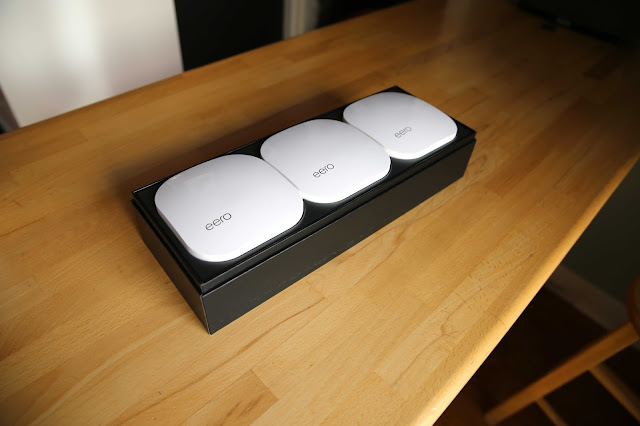Tuesday, June 13, 2017
Eero’s 2nd generation router is twice as fast and twice as powerful as the previous
Eero is back: a little over a year after kickstarting the home mesh networking trend, the company is announcing its second-generation hardware. According to the company, the new Eero provides double the speed and range of its predecessor, yet has the same footprint and form factor as before. The second-generation Eero is also the first product on the market with fully functioning Thread support, so it will be able to connect to a variety of smart home devices expected to arrive in the near future.
In addition to the new, faster, and more powerful hub, Eero is also releasing a smaller product called the Beacon. It is designed to extend the range and coverage of your Wi-Fi network just like the other hubs, but it has an even smaller size and plugs directly into a wall outlet. Starting today, you can order an Eero kit with one Eero hub and one Beacon for $299; $100 more gets you the hub and two Beacons. A “Pro” system is also available for $499, which includes three Eero hubs. All kits are expected to start shipping in a few weeks.
New hardware isn’t the only thing from Eero today — the company is also launching a new subscription service called Eero Plus. The service, which costs $9.99 per month or $99 per year, provides enhanced parental controls; a security service that Eero says will protect your network and devices from malware, ransomware, and phishing attacks; and priority access to Eero’s customer support. CEO Nick Weaver describes the services as “similar to Amazon Prime,” and says the company will add more features to it without raising the cost in the future.
Ever since Eero launched its first mesh router, the market has been flooded with similar ideas and systems. Incumbents like Netgear, Linksys, and TP-Link have all released mesh home router systems, and even Google and Samsung are in the router game now. All of the systems basically do the same thing: provide strong Wi-Fi coverage throughout your home by using multiple nodes, or router units, that are wirelessly linked together.
Eero’s first-generation product delivered on its claims, and it was be quite the solution to troublesome home networking problems. But the other systems that have come out since have either provided even faster speeds and stronger coverage, more services, or delivered a similar experience at a lower price.
With its new hardware and service plans, Eero hopes to close the gap and even surpass its competition. The new hub has a tri-band radio and can broadcast on three wireless bands at the same time (the first-gen model had a dual-band radio), and Eero says it is the smallest access point on the market with such a capability. Unlike the Netgear Orbi or Linksys Velop, Eero does not reserve one of the three bands just for communication between the units; Weaver says any one of the three bands can be used for sending data to devices or for communication between the nodes, depending on what the network demands are.
The Beacon is not as powerful as the new hub and does not have a tri-band radio, but Eero claims it provides 20 to 30 percent better performance than the first-generation Eero. It is half the size of the hub and is designed to placed in areas where power cords are unsightly or unable to be used, such as in stairwells, kitchens, and hallways. The Beacon also includes a downward-shining LED nightlight, which can be automatically controlled by the device’s ambient light sensor or with a manual schedule set in the Eero app. Both the new hub and the Beacon are backwards compatible with existing Eero systems, so current customers can add new hubs or Beacons to their networks as they see necessary.
Including Thread radio support is a bit of a bet on the future of smart home tech by Eero. Thread has been around as a smart home protocol for a few years, and a number of existing routers, such as Google’s OnHub line, have dormant Thread radios in them that have not yet been put to use. Thread is said to be simpler and easier to deploy than competing standards ZigBee and Z-Wave, but there aren’t yet any devices on the market that can make use of it. Weaver says that will change now that the new Eero comes with an active Thread radio: finally there will be a hub for Thread devices to connect to. These devices will likely include smart home staples such as lights, locks, and doorbells, and Weaver says the idea is you won’t have to use a secondary hub like SmartThings to connect your smart home devices.
The home router market is wildly different in 2017 than it was two years ago when Eero first broke cover, but Weaver says Eero is well-positioned to be a neutral party for your home network. While other companies, such as Google and Samsung, sell other devices that connect to Wi-Fi networks and may have different priorities based on those businesses, Eero is only focused on networking and doesn’t put any device ahead of another — whether it’s from Apple, Google, Amazon, Samsung, or another company.
Eero’s new products catch it up to the technical capabilities of the other mesh router systems without making them more complex or difficult to use than its earlier efforts. Given how popular its first products were, the new Eero devices should prove to be even more so.
Subscribe to:
Post Comments (Atom)

No comments:
Post a Comment